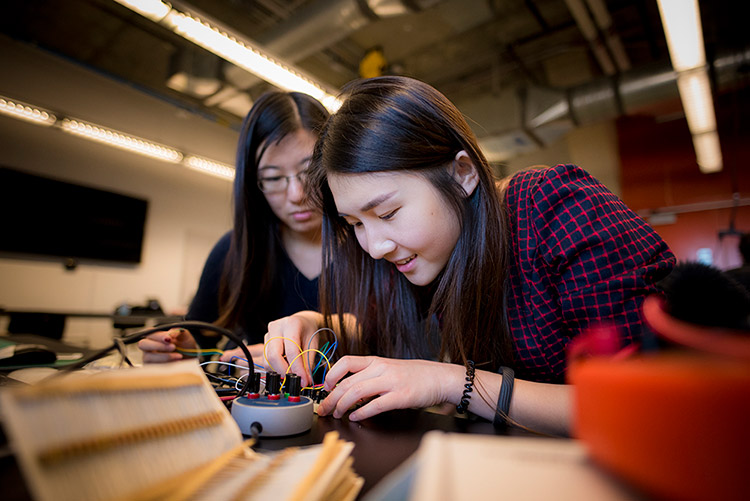
Arts and engineering students collaborate in new course at UC San Diego
Published Date
By:
- Deborah Osae-Oppong
Share This:
Article Content

Photo by Erik Jepsen/UC San Diego Publications
Students from a structural engineering and a visual arts class are working together, shoulder to shoulder, on a collaborative final project despite the fact that they are in different classes. This visual arts and engineering mashup is happening in the new EnVision Maker Studio at UC San Diego and involves students in Structural Engineering 1 and Visual Arts 40. Groups of two or three engineers and one artist are working together to create a sculpture and an engineered support structure.
The goal of this educational collaboration is to work collectively to create a “whole object” where the aesthetics and design of the sub-structure and art object are integrated in such a way that they work together aesthetically, conceptually, and structurally.
The artist in each group leads design and 3D printing (or other assembly method) for a 3D object representing their idea of science fiction. The engineers take the lead on the surrounding structure.
Professor Lelli Van Den Einde is teaching Structural Engineering 1 and professor Brett Stalbaum is teaching Visual Arts 40.
Squid monsters and more
One team designed, and is 3D-printing, a squid monster sculpture that will be presented on a pagoda-style structure the team also built and analyzed.
“Engineering students were asked to conceptually design with their artist a sub-structure to integrate with a 3D-printed sculpture,” said Lelli Van Den Einde, a professor in the Structural Engineering Department and one of the instructors for the course.
Then, the structural engineering students had to use theory they learned in class to decide whether the structure would support the weight of the sculpture and other loads that might be imposed on the structure (like wind load or someone hitting the structure from the side).
“It was a great learning experience for them because they were able to apply the theory they learned in class to a real application example and were able to build it, said Van Den Einde. “Very hands on.”
Another team designed and built a system to hold a suspended car sculpture.
A third team is constructing something akin to the big tic-tac-toe systems you see in playgrounds where you can turn the X and O cubes with your hands. This project, which merges the sculpture with the structure, aims to portray a physical version of a “rasterized image” and teach the students about how rasters work.
Students used design software; hand and prototyping tools; as well as 3D printers -- all in the EnVision maker studio -- to fabricate their designs in preparation for an exhibition during finals week, which is open to the public from March 14 to March 17 from 10AM to 5PM.
“Being able to define a joint project that meets course specific learning outcomes but also allows for cross-disciplinary collaboration was an interesting challenge for Professor Stalbaum and myself,” said Van Den Einde.
Students seemed genuinely excited about the project, she said.
“During the conceptual design phase, it was amazing to see that no two teams had the same vision for their sculpture and supporting structure,” said Van Den Einde.
“The sculpture is actually part of the structure…it’s a little different than we expected,” said Nicolette Nguyen, a UC San Diego sophomore who is enrolled in Structural Engineering 1 and is part of an engineering-visual arts team. “I am learning an absurd amount of engineering theory,” and that’s in addition to “the whole 3D printing shebang,” said Nguyen. “Having this studio and people like Jesse [DeWald, the EnVision staff director] around is great.”
Nguyen is part of the engineering and visual arts team that is making the physical version of a rasterized image. The project requires the team to 3D print 25 cylinders and create a structure to support them. Each cylinder will be painted 50 percent black and 50 percent white and strung up on their metal grid. People will be able to turn the cylinders to change their color as if they are flipping individual pixels from black to white.
The meanings of creativity
Van Den Einde notes that teamwork and communication issues that typically develop within a team in the same discipline were also present in these interdisciplinary teams, demonstrating the need to teach students to work in multi-disciplinary groups in preparation for their future role on diverse project teams.
Students in both visual arts and engineering majors are graduating into a world where the best opportunities assume collaboration in interdisciplinary work groups, in which our most challenging problems are being addressed using sometimes radically different problem solving strategies.
Brett Stalbaum, the Visual Arts professor co-leading this collaboration with Van Den Einde, notes that there is a remarkable history of over 100 years of computing in the arts practices and research that can inform this kind of trans-disciplinary thinking.
Collaboration is a way to help students experience the relevant lessons that history offers. Just as important, this kind of collaboration is basic preparation for a world that values interdisciplinary approaches over separating creative people across narrow disciplinary divides, he says.
“The class has been exciting because our students get to come together and ‘try on’ the differing roles of artist and engineer,” said Stalbaum. “This type of role play contributes to a critical sense of differing disciplinary subjectivities about what constitutes ‘creativity’, a very loaded term that many people assume the arts has some special relationship with. We do not, but what is true is that ‘creativity’ is culturally boxed up quite differently within different fields. Our students get to role-play and deploy some of each other’s differing approaches to problem solving, and even to learning itself.”
It unlocks a lot of creativity, and that makes it a lot of fun, he said.
Share This:
You May Also Like
Stay in the Know
Keep up with all the latest from UC San Diego. Subscribe to the newsletter today.


